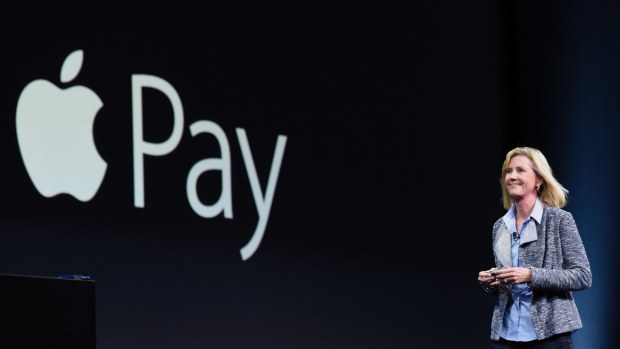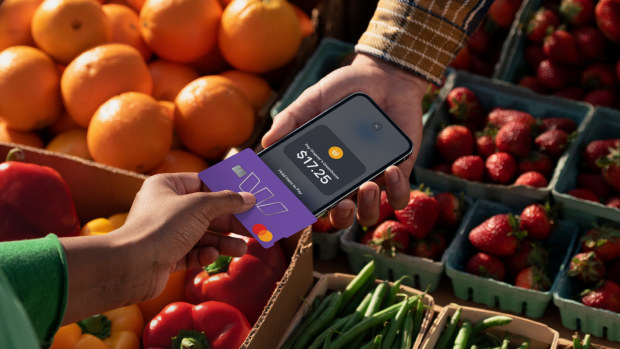
Apple will allow iPhones to be used to accept payments for the first time in Australia, a move Westpac – the first major bank to offer it to business customers – says forms part of a deeper partnership.
Tyro Payments will join Westpac switching on the ‘Tap to Pay’ service for merchants from Wednesday morning. They will be able to take payments from debit and credit cards, or other smartphones, into banking software hosted on iPhones without needing an additional payment terminal.
The move is designed to expand the payments market, generating higher fees for banks and Apple, which is continuing to push for a cashless society.

Jennifer Bailey, Apple’s vice president of Apple Pay and Apple Wallet, said Tap to Pay on iPhone “empowers Australian businesses to offer easy, secure, and private contactless payment experiences”. Bloomberg
ANZ, through its partnership with Worldline, along with payment fintechs Stripe, Till Payments and Zeller, are also working with Apple to enable the functionality in Australia in the coming months.
Apple will only allow banks and other payment providers to use iPhones for payments if they pay some of their merchant fees to Apple. Contractual terms have not been disclosed. Apple is already earning more than $110 million from Australian banks each year for allowing customers to pay using Apple Pay, its digital wallet.
Apple allows iPhones to receive payments in the United States and Taiwan; Australia, where contactless payments are highly popular, will be its third global market.

Chris de Bruin of Westpac: “Apple are providing infrastructure and an underlying operating system, on top of which we can craft a service experience where we retain the client relationship.” Louie Douvis
The arrival of Apple’s iPhone as a payment device will challenge banks’ revenue from selling or hiring payment terminals to small business, an area that Block also competes in via its Square business.
But Westpac’s chief executive of consumer and business banking Chris de Bruin said any lost revenue from supplying terminals would be more than made up by expanding mobile payments by making it easier for more small businesses to accept them.
“We see this as entirely additive. We don’t see there being a trade-off here, where we are taking a step backwards economically. The numbers work well for us under our projections,” he told The Australian Financial Review.
He confirmed Westpac will charge a flat fee to businesses accepting payments with mobile phones, as part of the overall cost of using its payment services and banking software.
The new strategic partnership with Apple in an area of banking known as “merchant acquiring” provides a head start for Westpac against the other major banks. It comes after ANZ was the first to switch on Apple Pay for retail customers in 2016, allowing ‘tap and go’ payments to be made using iPhones, forcing the other banks to eventually follow.
But the role of Apple facilitating payments for businesses is different to its moves into consumer payments, Mr de Bruin said.

Apple has introduced Tap to Pay on iPhone in Australia alongside Westpac and Tyro.
“Unlike Apple Pay, this is a Westpac experience on software that Westpac loads on the phone,” he said.
“Apple’s underlying pathways and software integrates with ours, rather than the other way around on Apple Pay where we load into the wallet. Here, we can craft an experience for our clients under our control, and present differentiated customer propositions, which is great for customer choice.”
Nevertheless, Apple’s move into payment acceptance comes as banks are on high alert about its ultimate intentions in financial services.
In April, Apple announced, via a partnership with Goldman Sachs, which provides a credit card for Apple Wallet in the US, that it would offer a savings account offering 4.15 per cent interest. In March, Apple also launched a buy now, pay later service in the United States.
It is understood that Apple is not currently contemplating similar moves into Australian consumer lending or savings accounts.
Despite the potential for iPhones to replace Square’s payment terminals, Block is partnering with Apple in the US and has been using iPhones to reduce costs and drive more users to its business software, which includes inventory management, and lending to SMEs. Westpac and other banks also hope to lift lending and deposit gathering on the back of iPhones being used for payments by business customers.
From Wednesday, Westpac’s EFTPOS Air iOS app, which is linked to a bank account, will be available on Apple’s App Store. Once enabled, merchants will be able to receive payments from other smartphones and contactless credit or debit card provided by Visa, Mastercard, eftpos or American Express.
iPhone payments are expected to initially be taken up by sole traders, tradies, smaller retailers and hospitality venues including restaurants, along with other businesses using cash because they cannot afford to lease payment terminals from banks.
Transactions will be processed through ‘near-field communications’ (NFC) chips in the iPhones, which Apple only makes available to banks that meet its certification standards and pay its commercial fees. Apple will not know what is being purchased through its phones or who is buying goods. The product level data stays with customers and banks.
The move comes as Apple faces pressure from the Australian Parliament and the Reserve Bank of Australia, which has called for new powers to allow it to regulate Apple as a payment service provider. RBA governor Philip Lowe said this power could be used to investigate how Apple grants access to its NFC antenna.
But Apple has argued against regulation, saying it is acting as a platform and a facilitator of transactions and that it does not touch the money or process transactions, which are left to banks and other regulated payments providers.
Mr de Bruin said Westpac is not worried about Apple moving in on its “merchant acquiring” business.
“Apple is doing facilitation for us, but we are doing the payment,” he said. “This is about them helping us. They are a service provider. We are very comfortable with the ecosystem that has been built here. We have had a very productive relationship with Apple we see them as partner in this.”
“We have seen a strong collaboration, where they are providing infrastructure and an underlying operating system, on top of which we can craft a service experience where we retain the client relationship. It is different to the fears when Apply Pay came in originally, when there were concerns about disintermediation. Here, Apple is doing facilitation which is helpful to consumers.”
Jennifer Bailey, Apple’s vice president of Apple Pay and Apple Wallet, said in a media release that Tap to Pay on iPhone would empower Australian businesses “to offer easy, secure, and private contactless payment experiences to their customers and help them run and grow their business”.
The functionality will work on an iPhone X or later device running iOS 16.4 or a later version of the operating system. Apple Wallet is also being made available to app developers, including those offering transit cards, ticketing, loyalty, health insurance, digital car keys and student IDs.
"payment" - Google News
May 17, 2023 at 04:00AM
https://ift.tt/fn91UNR
Apple iPhones can now take payments for Westpac and Tyro - The Australian Financial Review
"payment" - Google News
https://ift.tt/H65YXTn
https://ift.tt/e4MSRjH
Bagikan Berita Ini














0 Response to "Apple iPhones can now take payments for Westpac and Tyro - The Australian Financial Review"
Post a Comment